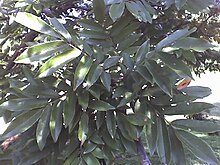메카
mecA메카(mecA)[1]는 박테리아 세포에서 발견되는 유전자로 메티실린, 페니실린, 그리고 다른 페니실린과 같은 항생제에 내성을 가질 수 있게 해준다.null
메카(mecA)를 옮기는 것으로 가장 흔히 알려진 박테리아 변종은 메티실린 내성 포도상구균(MRSA)이다.포도상구균종에서는 포도상구균 염색체 카세트 SCCMEC 유전원소를 통해 메카(mecA)가 전파된다.[2]저항성 변종은 많은 병원 감염을 유발한다.[3]null
메카(mecA)는 박테리아 세포벽 형성을 돕는 트랜스펩티다제인 PBP2A(페니실린 결합 단백질 2A) 단백질을 암호화하고 있다.PBP2A는 DD-트랜스펙티다제보다 메티실린, 페니실린 등 베타락탐 항생제에 대한 친화력이 낮아 페니실린 유사 항생제의 고리 같은 구조와 결합하지 않는다.이것은 베타 락탐이 존재하는 곳에서 트랜스펩티다아제 활동을 가능하게 하여 세포벽 합성을 억제하는 것을 방지한다.[4]그러면 그 박테리아는 정상적으로 복제될 수 있다.null
역사
메티실린 내성은 보다 공격적이어서 메티실린 치료에 반응하지 못한 포도상구균 아우레우루스 병원에서 처음 나타났다.[5]이 변종인 MRSA의 유병률은 계속 증가하여 영국 병원의 60%에 이르렀으며, 전 세계적으로, 그리고 병원 환경 이상으로 퍼져나갔다.[5][6]연구원들은 모든 알려진 MRSA 변종에 존재하는 이동 유전적 요소인 포도상구균 카세트 염색체 mec를 통해 얻은 메카 유전자에 대한 이러한 저항의 근원을 추적했다.[7]2017년 2월 27일 세계보건기구(WHO)는 MRSA를 박테리아 내성 병원균 우선 목록에 올려 추가 연구 및 치료 개발을 위한 높은 우선순위 대상으로 삼았다.[8]null
탐지
MRSA의 성공적인 치료는 보통 PCR(중합효소 연쇄반응)을 통한 메카 검출에서 시작된다.다른 방법으로는 효소 검출 PCR이 있는데, PCR에는 면역 흡수제 측정으로 검출 가능한 효소로 라벨을 붙인다.이것은 시간이 덜 걸리고 비용이 많이 들고, 지루하고, 예측할 수 없는 젤 전기식품을 필요로 하지 않는다.[9]세포시틴 디스크 확산은 메티실린 내성 균주뿐만 아니라 내성이 낮은 균주에 대해서도 시험하기 위해 표현형 저항을 사용한다.[10]메카만 존재한다고 해서 내성 균주가 결정되는 것은 아니다; 메카 양성 균주의 추가적인 표현형 분석은 그 균주가 메티실린에 얼마나 내성이 있는지를 결정할 수 있다.[11]이러한 표현형 분석은 단백질 양과 저항성 사이에 아무런 연관성이 없기 때문에 메카소의 단백질 제품인 PBP2a의 축적에 의존할 수 없다.[12]null
구조
메카(mecA)는 이 유전자가 수평 유전자 전이를 거치고 숙주 종에 자신을 삽입할 수 있는 이동 유전자 원소인 포도상구균 카세트 염색체 mc에 있다.[13]이 카세트는 메카(mecA)와 두 개의 재조합형 유전자인 crA와 crB가 들어 있는 52킬로바이트 DNA 조각이다.[7]호스트 게놈에 메카 콤플렉스를 적절히 삽입하려면 재조합이 필요하다.연구자들은 다수의 유전적 변종을 S. aureus의 저항성 변종으로부터 격리시켰지만, 모든 변종들은 유사하게 기능하며 복제의 숙주 DNA 원점에 가까운 동일한 삽입 부지를 가지고 있다.[14]mecA는 또한 두 개의 규제 단위인 mecI와 mecR1을 가진 단지를 형성한다.이 두 유전자는 메카아를 억제할 수 있다; 이 유전자의 삭제나 녹아웃은 메티실린에 대한 S. aureus의 저항력을 증가시킨다.[15]인간과 격리된 S. aureus 변종은 이러한 규제 요소가 없거나 메카(mecA)를 억제하는 단백질 제품의 기능 상실을 일으키는 돌연변이를 포함하고 있다.이것은 결국 메카에 대한 구성적 전사를 야기한다.[16]이 카세트 염색체는 종 사이에서 움직일 수 있다.S.epidermidis와 S.haemolyticus라는 다른 두 종의 포도상구균은 메카뿐만 아니라 카세트 염색체가 운반할 수 있는 다른 비필수 유전자에 대해서도 이 삽입 사이트에서 보존을 보여준다.[17]null
저항 메커니즘
페니실린, 그 유도체와 메티실린, 그리고 다른 베타락탐 항생제는 페니실린 결합 단백질 제품군을 형성하는 세포벽의 활동을 억제한다(PBP 1, 2, 3, 4).이것은 세포벽 구조를 교란시켜 세포질이 새고 세포가 죽게 만든다.[18]단, 세포벽의 구조적 건전성을 유지시켜 세포사멸을 방지하는 베타락탐에 친화력이 낮은 PBP2a의 메카코드.[18]S. aureus의 박테리아 세포벽 합성은 transglycosylation에 의존하여 설탕모노머의 선형 중합체를 형성하고 transptization을 형성하여 새로 개발된 세포벽을 강화한다.PBPs는 트랜스펩티다아제 도메인을 가지고 있지만, 과학자들은 트랜스글리코실화 촉매를 촉진하는 단오작성 효소만 생각했지만, PBP2는 두 가지 필수 과정을 모두 수행할 도메인을 가지고 있다.[19]항생제가 매개체에 들어가면 전이 영역에 결합하고 PBP가 뮤로프티드를 교차 연결하지 못하도록 억제해 안정적인 세포벽 형성을 방해한다.협업 작용으로 PBP2a는 항생제에 대한 적절한 수용체가 부족하고 전이작용을 지속해 세포벽 파괴를 예방한다.[20]PBP2a의 기능은 S. aureus의 세포벽에 있는 두 가지 구조적 요인에 따라 달라진다.첫째, PBP2a가 세포벽에 제대로 맞기 위해서는 트랜스펩타이드화를 계속하기 위해서는 적절한 아미노산 잔류물, 특히 펜타글리신 잔류물과 첨가된 글루탐산 잔여물이 필요하다.[21]둘째, PBP2a는 효과적인 트랜스펩티다제 활성을 가지고 있지만 다당류 단량체로 세포벽의 백본을 형성하는 PBP2의 트랜스글리코실레이션 영역이 없으므로 PBP2a가 이 과정을 계속하기 위해서는 PBP2에 의존해야 한다.[21][20]후자는 내성적인 S. aureus에서 세포벽 합성을 방지하기 위해 베타 락텀의 능력을 향상시키기 위한 치료목표를 형성한다.세포벽 합성에 관여하는 글리코실라아제의 억제제를 식별하고 그 표현을 조절하면 베타락탐 치료에 대해 이전에 내성이 있던 박테리아를 재감축할 수 있다.[22]예를 들어 녹차에서 발견되는 화합물인 에피케친 갈레이트는 PBP2와 PBP2a에 작용하는 옥사실린이 세포벽 형성을 효과적으로 억제할 정도로 베타락탐에 대한 저항력을 낮추는 징후를 보였다.[23]null
다른 유전자와의 상호작용은 S. aureus의 저항성 변종에서 베타 락텀에 대한 저항을 감소시킨다.이러한 유전자 네트워크는 주로 세포분열, 세포벽 합성 및 기능에 관여하는데, 여기서 PBP2a가 국부화된다.[24]게다가, 다른 PBP 단백질은 항생제에 대한 S. aureus의 저항에도 영향을 미친다.PBP4 발현이 억제되었을 때 S. aureus 변종에서 옥사실린 저항은 감소했지만 PBP2a는 감소하지 않았다.[25]null
진화사
mecA는 숙주 게놈에 자신을 삽입하는 이동 유전자를 통해 획득되고 전송된다.그 구조는 포도상구균의 메카 유전자 제품과 동질성 메카 유전자 제품 사이에 보존되어 있다.2007년 현재 S. sicuri의 mecA 호몰로게이션의 기능은 아직 알려져 있지 않지만, S. aureus에서 발견된 mecA 유전자의 전조일 수도 있다.[26]이 호몰로뉴의 단백질 생산물의 구조는 매우 유사하여 단백질을 S. aureus에서 사용할 수 있다.항생제 민감성 S. aureus에 베타락탐 저항성 S. sicuri의 메카 호몰로뉴를 삽입하면 항생제 내성이 높아진다.두 종 모두 사용하는 무로프티데스(펩티도글리칸 전구체)는 같지만, 베타락탐이 PBP 단백질 계열을 억제할 때 S. scuri의 메카 유전자의 단백질 산물은 세포벽 합성을 계속할 수 있다.[27]null
메카, 특히 포도상구균 카세트 염색체에서 발견된 메카 복합체를 더욱 이해하기 위해 연구자들은 다른 포도상구균 종에 비해 S. scicuri에서 추출한 메카 유전자를 사용했다.뉴클레오티드 분석은 메카 순서가 포도상구균 카세트 염색체에서 메카 유전자의 유래에 가장 중요한 후보인 포도상구균 플뢰레티균에서 발견된 메카 호몰로뉴와 거의 일치한다는 것을 보여준다.S. fleureti의 게놈은 이 유전자를 포함하고 있기 때문에 카세트 염색체는 다른 종에서 유래해야 한다.[28]null
참조
- ^ Ubukata K, Nonoguchi R, Matsuhashi M, Konno M (May 1989). "Expression and inducibility in Staphylococcus aureus of the mecA gene, which encodes a methicillin-resistant S. aureus-specific penicillin-binding protein". Journal of Bacteriology. 171 (5): 2882–5. doi:10.1128/jb.171.5.2882-2885.1989. PMC 209980. PMID 2708325.
- ^ Deurenberg RH, Stobberingh EE (March 2009). "The molecular evolution of hospital- and community-associated methicillin-resistant Staphylococcus aureus". Current Molecular Medicine. 9 (2): 100–15. doi:10.2174/156652409787581637. PMID 19275621.
- ^ Wielders CL, Fluit AC, Brisse S, Verhoef J, Schmitz FJ (November 2002). "mecA gene is widely disseminated in Staphylococcus aureus population". Journal of Clinical Microbiology. 40 (11): 3970–5. doi:10.1128/jcm.40.11.3970-3975.2002. PMC 139644. PMID 12409360.
- ^ Fogarty LR, Haack SK, Johnson HE, Brennan AK, Isaacs NM, Spencer C (2015). "Staphylococcus aureus and methicillin-resistant S. aureus (MRSA) at ambient freshwater beaches". Journal of Water and Health. 13 (3): 680–92. doi:10.2166/wh.2014.278. PMID 26322754.
- ^ a b Lowy FD (May 2003). "Antimicrobial resistance: the example of Staphylococcus aureus". The Journal of Clinical Investigation. 111 (9): 1265–73. doi:10.1172/JCI18535. PMC 154455. PMID 12727914.
- ^ Basset P, Feil EJ, Zanetti G, Blanc DS (2011). Tibayrenc M (ed.). Genetics and Evolution of Infectious Disease. London: Elsevier. pp. 669–688. doi:10.1016/B978-0-12-384890-1.00025-X. ISBN 9780123848901.
- ^ a b Katayama Y, Ito T, Hiramatsu K (June 2000). "A new class of genetic element, staphylococcus cassette chromosome mec, encodes methicillin resistance in Staphylococcus aureus". Antimicrobial Agents and Chemotherapy. 44 (6): 1549–55. doi:10.1128/aac.44.6.1549-1555.2000. PMC 89911. PMID 10817707.
- ^ "Global priority list of antibiotic-resistant bacteria to guide research, discovery, and development of new antibiotics". World Health Organization. Retrieved 2017-11-28.
- ^ Ubukata K, Nakagami S, Nitta A, Yamane A, Kawakami S, Sugiura M, Konno M (July 1992). "Rapid detection of the mecA gene in methicillin-resistant staphylococci by enzymatic detection of polymerase chain reaction products". Journal of Clinical Microbiology. 30 (7): 1728–33. doi:10.1128/jcm.30.7.1728-1733.1992. PMC 265371. PMID 1629327.
- ^ Anand KB, Agrawal P, Kumar S, Kapila K (2009). "Comparison of cefoxitin disc diffusion test, oxacillin screen agar, and PCR for mecA gene for detection of MRSA". Indian Journal of Medical Microbiology. 27 (1): 27–9. doi:10.1016/S0255-0857(21)01748-5. PMID 19172055.
- ^ Bignardi GE, Woodford N, Chapman A, Johnson AP, Speller DC (January 1996). "Detection of the mec-A gene and phenotypic detection of resistance in Staphylococcus aureus isolates with borderline or low-level methicillinresistance". The Journal of Antimicrobial Chemotherapy. 37 (1): 53–63. doi:10.1093/jac/37.1.53. PMID 8647774.
- ^ Parvez MA, Shibata H, Nakano T, Niimi S, Fujii N, Arakaki N, Higuti T (August 2008). "No relationship exists between PBP 2a amounts expressed in different MRSA strains obtained clinically and their beta-lactam MIC values". The Journal of Medical Investigation. 55 (3–4): 246–53. doi:10.2152/jmi.55.246. PMID 18797139.
- ^ Hanssen AM, Ericson Sollid JU (February 2006). "SCCmec in staphylococci: genes on the move". FEMS Immunology and Medical Microbiology. 46 (1): 8–20. doi:10.1111/j.1574-695X.2005.00009.x. PMID 16420592.
- ^ Hanssen AM, Sollid JU (May 2007). "Multiple staphylococcal cassette chromosomes and allelic variants of cassette chromosome recombinases in Staphylococcus aureus and coagulase-negative staphylococci from Norway". Antimicrobial Agents and Chemotherapy. 51 (5): 1671–7. doi:10.1128/AAC.00978-06. PMC 1855542. PMID 17307983.
- ^ Kuwahara-Arai K, Kondo N, Hori S, Tateda-Suzuki E, Hiramatsu K (December 1996). "Suppression of methicillin resistance in a mecA-containing pre-methicillin-resistant Staphylococcus aureus strain is caused by the mecI-mediated repression of PBP 2' production". Antimicrobial Agents and Chemotherapy. 40 (12): 2680–5. doi:10.1128/AAC.40.12.2680. PMC 163603. PMID 9124822.
- ^ Cano I, Alonso MC, Garcia-Rosado E, Saint-Jean SR, Castro D, Borrego JJ (March 2006). "Detection of lymphocystis disease virus (LCDV) in asymptomatic cultured gilt-head seabream (Sparus aurata, L.) using an immunoblot technique". Veterinary Microbiology. 113 (1–2): 137–41. doi:10.1016/j.vetmic.2005.10.024. PMID 16298500.
- ^ Takeuchi F, Watanabe S, Baba T, Yuzawa H, Ito T, Morimoto Y, Kuroda M, Cui L, Takahashi M, Ankai A, Baba S, Fukui S, Lee JC, Hiramatsu K (November 2005). "Whole-genome sequencing of staphylococcus haemolyticus uncovers the extreme plasticity of its genome and the evolution of human-colonizing staphylococcal species". Journal of Bacteriology. 187 (21): 7292–308. doi:10.1128/JB.187.21.7292-7308.2005. PMC 1272970. PMID 16237012.
- ^ a b Stapleton PD, Taylor PW (2002-02-15). "Methicillin resistance in Staphylococcus aureus: mechanisms and modulation". Science Progress. 85 (Pt 1): 57–72. doi:10.3184/003685002783238870. PMC 2065735. PMID 11969119.
- ^ Reed P, Veiga H, Jorge AM, Terrak M, Pinho MG (May 2011). "Monofunctional transglycosylases are not essential for Staphylococcus aureus cell wall synthesis". Journal of Bacteriology. 193 (10): 2549–56. doi:10.1128/JB.01474-10. PMC 3133172. PMID 21441517.
- ^ a b Pinho MG, de Lencastre H, Tomasz A (September 2001). "An acquired and a native penicillin-binding protein cooperate in building the cell wall of drug-resistant staphylococci". Proceedings of the National Academy of Sciences of the United States of America. 98 (19): 10886–91. doi:10.1073/pnas.191260798. PMC 58569. PMID 11517340.
- ^ a b Guignard B, Entenza JM, Moreillon P (October 2005). "Beta-lactams against methicillin-resistant Staphylococcus aureus". Current Opinion in Pharmacology. Anti-infectives/New technologies. 5 (5): 479–89. doi:10.1016/j.coph.2005.06.002. PMID 16095969.
- ^ Huber J, Donald RG, Lee SH, Jarantow LW, Salvatore MJ, Meng X, Painter R, Onishi RH, Occi J, Dorso K, Young K, Park YW, Skwish S, Szymonifka MJ, Waddell TS, Miesel L, Phillips JW, Roemer T (August 2009). "Chemical genetic identification of peptidoglycan inhibitors potentiating carbapenem activity against methicillin-resistant Staphylococcus aureus". Chemistry & Biology. 16 (8): 837–48. doi:10.1016/j.chembiol.2009.05.012. PMID 19716474.
- ^ Bernal P, Lemaire S, Pinho MG, Mobashery S, Hinds J, Taylor PW (July 2010). "Insertion of epicatechin gallate into the cytoplasmic membrane of methicillin-resistant Staphylococcus aureus disrupts penicillin-binding protein (PBP) 2a-mediated beta-lactam resistance by delocalizing PBP2". The Journal of Biological Chemistry. 285 (31): 24055–65. doi:10.1074/jbc.M110.114793. PMC 2911331. PMID 20516078.
- ^ Lee SH, Jarantow LW, Wang H, Sillaots S, Cheng H, Meredith TC, Thompson J, Roemer T (November 2011). "Antagonism of chemical genetic interaction networks resensitize MRSA to β-lactam antibiotics". Chemistry & Biology. 18 (11): 1379–89. doi:10.1016/j.chembiol.2011.08.015. PMID 22118672.
- ^ Memmi G, Filipe SR, Pinho MG, Fu Z, Cheung A (November 2008). "Staphylococcus aureus PBP4 is essential for beta-lactam resistance in community-acquired methicillin-resistant strains". Antimicrobial Agents and Chemotherapy. 52 (11): 3955–66. doi:10.1128/AAC.00049-08. PMC 2573147. PMID 18725435.
- ^ Fuda C, Suvorov M, Shi Q, Hesek D, Lee M, Mobashery S (July 2007). "Shared functional attributes between the mecA gene product of Staphylococcus sciuri and penicillin-binding protein 2a of methicillin-resistant Staphylococcus aureus". Biochemistry. 46 (27): 8050–7. doi:10.1021/bi7004587. PMID 17567045.
- ^ Severin A, Wu SW, Tabei K, Tomasz A (October 2005). "High-level (beta)-lactam resistance and cell wall synthesis catalyzed by the mecA homologue of Staphylococcus sciuri introduced into Staphylococcus aureus". Journal of Bacteriology. 187 (19): 6651–8. doi:10.1128/JB.187.19.6651-6658.2005. PMC 1251583. PMID 16166526.
- ^ Tsubakishita S, Kuwahara-Arai K, Sasaki T, Hiramatsu K (October 2010). "Origin and molecular evolution of the determinant of methicillin resistance in staphylococci". Antimicrobial Agents and Chemotherapy. 54 (10): 4352–9. doi:10.1128/AAC.00356-10. PMC 2944575. PMID 20679504.


